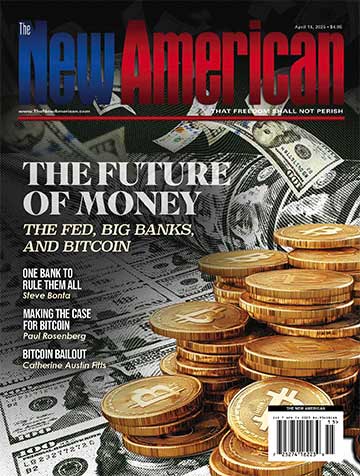
The popular image of Bastille Day, indeed of the French Revolution itself, is that the liberty-loving French folk in Paris spontaneously rose up against a tyrannical king and his haughty wife, and heroically stormed the symbol of the Old Regime — the prison fortress known as the Bastille — liberating hundreds of political prisoners. This led to an abolition of the monarchy and the establishment of a government dedicated to liberty for all the people of France.
Nothing could be further from the truth.
The French Revolution was actually the fruit of decades of radical agitation stirred up by anti-Christian, power-seeking secret societies which drank freely from the poison well of the Enlightenment, and it has served as the template for every radical leftist revolution since that time.
The first dictator of the Soviet Union, Vladimir Lenin, praised the French Revolution as a model for his own, saying, “although it was crushed, the French Revolution was nevertheless triumphant.” It was favorably referenced by other Communists, such as Karl Marx and Ho Chi Minh. Today we can discern the Revolution’s radicalism in the rhetoric of the modern Left.
To understand why such men of the Left so admired the French Revolution, with its savage attacks upon Christianity, liberty, property, and life itself — symbolized by the guillotine for “enemies of the people” — we need only note how and why it came about. This will also reveal why the popular image described above of the storming of the Bastille is a gross fabrication of actual historical events.
Obviously only so much can be said in a short article; however, to begin: The seeds of the French Revolution were sown in the cafes, coffee houses, and secret societies that emerged in the Enlightenment. This is not to say that the entire Enlightenment was evil, but many of the personalities and ideas which emerged from it were certainly radical. The Enlightenment has been described as a philosophical movement which grew in strength in Europe throughout much of the 18th century. It was marked by an increasing opposition to the existing order, specifically orthodox Christianity.
For example, among the most important events of the Enlightenment was the publication between 1751 and 1772 of the 35-volume Encylopedia, compiled by the intensely anti-Christian Denis Diderot, and others of like mind. The first edition even featured a winged Lucifer on its title page. (One might note that Saul Alinsky dedicated his 1971 book Rules for Radicals to Lucifer, also known as the devil or Satan.) Few Enlightenment figures were openly atheist, but instead held to a new worldview known as deism. Under deism, God is the Creator, but His intervention into human affairs is denied, and the authority of the Bible is questioned, with particular opposition to literal miracles. In other words, it is a religious view which leaves man unrestrained.
Many of these Enlightenment figures became increasingly radical. A radical is defined as a person who desires the destruction of the present society, replacing it with a new order in the world.
With the continuing spread of these ideas — discussed openly in cafes, coffee houses, reading rooms, salons, and the like across Europe — some of these radicals began to discuss revolution, in secret societies.
One of these secret societies, the Bavarian Illuminati, was formed by Adam Weishaupt on May 1, 1776 (note that today Communists around the world celebrate May 1). Weishaupt’s godfather, Johann Adam Freiherr von Ickstatt, raised him after the death of the boy’s father. Ickstatt was deeply into the more radical ideas of the Enlightenment, and passed his rationalist views onto his godson. Weishaupt received his doctorate in law at the University of Ingolstadt, and became a law professor. He envisioned a society of “illumination, enlightening the understanding by the sun of reason, which will dispel the clouds of superstition and of prejudice.”
In his new book, To the Victors Go the Myths and Monuments, John Birch Society CEO Art Thompson lists the major goals of the Illuminati: 1) the destruction of Christianity; 2) the destruction of nations as such in favor of universal internationalism; 3) the discouragement of patriotism and the substitution of the cry for universal brotherhood; 4) the abolition of family ties and marriage by means of systematic corruption; and 5) the suppression of the rights of inheritance and property.
It is obvious that these nefarious goals are largely shared by many on the Left today. Some even postulate that this very same Illuminati is alive and well in our own time, directing an evil conspiracy to achieve this outcome. While it would be difficult to draw a direct line from the Illuminati to modern communists, socialists, and other radicals of our day, perhaps an illustration will help explain the ancestry of the philosophy of today’s radical Left. If a man is standing far back from a wooded area, and watches as a white horse with a brown mane runs into the woods, and a white horse with a brown mane emerges a few minutes later at the other end of the woods, it is safe to assume that it is the same horse.
While there may not even be an organization today which is known as the Illuminati, the basic goals of this organization from the 1700s are the same as those of radical leftists today. Perhaps the name has been changed — to protect the guilty.
Certainly, the ideas found in the Illuminati permeated radical clubs of pre-revolution France. The ruler of Bavaria, Elector Karl Theodor, became alarmed at the subversive intentions of the Illuminati and declared it illegal. With its banishment in Bavaria in 1784, the secret society migrated to Paris, which was awash in Enlightenment radicalism and multiple radical clubs that shared many of the ideas promoted by the Illuminati.
Whereas King Louis XVI and his wife, Marie Antoinette, are usually portrayed in the history books and in popular culture as tyrants of the worst sort, the truth is quite different. Marie Antoinette supposedly once remarked, “Let them eat cake,” in response to being informed that the poor had no bread. The real Antoinette said no such thing. In fact she lodged and fed 12 poor families, at her own expense, at Trianon. She founded the Society of Ladies of Maternal Charity. She even once stopped her carriage for over an hour to aid an injured person, and waited until a surgeon was located.
Historian Antonia Fraser disputed this cruel libel in her book Marie Antoinette, the Journey, writing, “As a handy journalistic cliché [“Let them eat cake”], it may never die,” adding that “such ignorant behavior would have been quite out of character. The unfashionably philanthropic Marie Antoinette would have been far more likely to bestow her own cake impulsively upon the starving people before her.”
Perhaps the greatest error of Marie Antoinette’s husband, Louis XVI of the House of Bourbon, was involving his nation in the war between Great Britain and her American colonies. Most of the debt of France was incurred before he came to the throne, during the four wars of Louis XIV, followed by the Seven Years’ War (known as the French and Indian War in America) under Louis XV. France had no business involving itself in yet another war. While some modern Americans even use the French intervention as a justification for American intervention into the affairs of other countries today, it could just as well be cited as a reason to refrain from such foreign adventures. It is not certain if Louis could have avoided national bankruptcy even if he had opted to stay out of the American Revolution, but he no doubt deepened the problem and hastened his own demise by jumping in.
By 1788, the fiscal situation for the French government was desperate, and Louis XVI called the Estates-General to help him. The Estates-General was divided into the three “Estates,” the first being the clergy, the second, the nobility, and the third, everyone else.
The radicals sensed that their time had come. On June 10, 1789, the Third Estate urged the nobles and the clergy to unite with them. Many did, and on June 17 they proclaimed themselves the National Assembly of France. On June 20, the new National Assembly found the meeting hall closed, so the deputies went to a nearby indoor tennis court to escape the rain. There, they took the Tennis-Court Oath, in which they pledged not to adjourn until they had adopted a new constitution for France.
The king’s cousin, the Duke of Orleans, began bribing hungry Parisians to rebel and overthrow the government. Thousands stood outside bakeries all day, waiting for bread. Rumors of all sorts were floated among the populace: one had it that the king had even mined the meeting hall of the National Assembly. On July 13, mobs were led to break into gunsmiths’ shops, searching for weapons. A new rumor circulated on July 14, causing the greatest alarm yet. According to this rumor, soldiers were supposedly poised to attack the city.
At this point, someone suggested that the mob attack the Hôtel des Invalides, where they found nearly 30,000 muskets. But since there were few cartridges, and only small stores of powder, someone then shouted that they should storm the Bastille, which was said to contain vast stores of both cartridges and gunpowder.
While the French Revolution has been presented as a spontaneous uprising, it seems there was guidance every step along the way.
The Bastille was a 14th-century castle that Louis XVI would have already destroyed, but he lacked the funds. At one time, during the absolute rule of his great-great-great grandfather, the “Sun King,” Louis XIV, the Bastille had housed hundreds of political prisoners. Now, it housed only seven inmates, four of whom were forgers, one in the jail for incest, and two others, probably insane. None was a “political” dissident.
But all this information was unknown to the mob. They were told the Bastille still held hundreds of political dissidents, suffering horrific tortures within its thick walls. Someone in the mob shouted that cannons atop the Bastille could kill many in the enraged Paris mob. Upon hearing this, the governor of the Bastille, Bernard-René De Launay, directed that the cannons be withdrawn from visibility. At this, someone shouted that they were loading the cannons, with intentions of murdering the mob.
Rather than fight, De Launay chose to open the doors. With shouts from within the mob to kill them all, De Launay was butchered — shot and stabbed. A sword was used, along with a pocket knife, to decapitate him. His severed head was then placed at the end of a pike and paraded through the streets of Paris.
Rumors spread that hundreds of political prisoners had been liberated from the Bastille.
This whole episode is hardly something to celebrate; however, it is held up by many — not only in France, but around the world, including in the United States — as somehow the equivalent of the embattled farmers standing at Lexington and Concord and firing the shot heard ‘round the world.
What nonsense!
The French Revolution became increasingly radical and violent. Louis XVI and Marie Antoinette were sent to the guillotine by a vote of the National Convention, which had been called by the National Assembly to write a new constitution for France. The National Convention now considered itself the ruling body of France, led by Jacobin Club radicals Maximilian Robespierre and Georges Danton, and they implemented a Reign of Terror, executing thousands of average French citizens with the sharp blade of the guillotine. While in power, the National Convention went to work in a fevered attempt to uproot the existing order in France. They voted to abolish Christianity, using church buildings and cathedrals as “temples of reason,” and substituting Enlightenment radicals such as Voltaire in place of Christian saints. They changed the calendar, the law code, and even playing cards (with soldiers and workers replacing kings and queens). One might say that the Jacobins closely resembled the same “horse” as the Illuminati.
Perhaps the radical frenzy of the National Convention, with the supposed purpose of simply writing a new constitution, partly explains James Madison’s fear of a second constitutional convention in America. Unfortunately, far too many are willing to take such a risk today, even with an American political class heavily populated with radicals, many spouting rhetoric amazingly similar to that of the Jacobins, the Illuminati, and other radical secret societies of that day.
Certainly George Washington was no supporter of the radical takeover of France. He feared that the madness that destroyed the existing order of France had made its way to America. In a letter written in the 1790s (long after some today argue that the Illuminati had ceased to exist), Washington declared, “It was not my intention to doubt that the doctrines of the Illuminati, and principles of Jacobinism had not spread in the United States. On the contrary, no one is more truly satisfied of this fact than I am. The idea that I meant to convey, was, that I did not believe that the Lodges of Free Masons in this Country had, as Societies, endeavored to propogate the diabolical tenets of the first, or pernicious principles of the latter (if they are susceptible of separation). That individuals of them may have done it, or that the founder, or instrument employed to found, the democratic societies in the United States, may have had these objects; and actually had a separation of the people from their government in view, is too evident to be questioned.”
Washington feared that the doctrines of the Illuminati — which had fostered the madness of the French Revolution through the Jacobins and other such radical clubs — had also been at work in the radical clubs in America, the so-called democratic societies.
It is inconceivable that the “Father of our country” would have approved of considering the storming of the Bastille and the violent French Revolution as anything to celebrate.
Photo of 2015 Bastille Day celebrations in Paris: AP Images
Steve Byas is a professor of history at Randall University, in Moore, Oklahoma. His book History’s Greatest Libels includes a chapter on the libeling of French Queen Marie Antoinette, as well as chapters defending other personalities in history from various falsehoods, such as Joe McCarthy, Christopher Columbus, and others.




